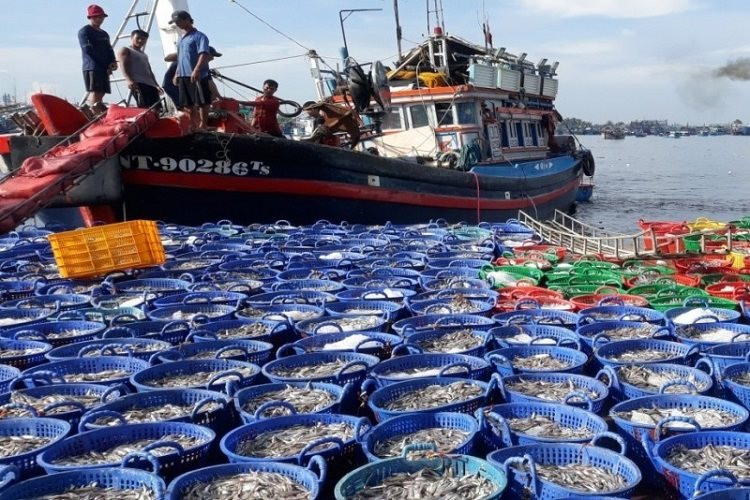Approval of Planning for the protection and exploitation of aquatic resources for the period 2021–2030 in Vietnam
What are the details of the Planning for the protection and exploitation of aquatic resources for the period 2021–2030 in Vietnam approved by the Prime Minister? - Minh Nhat (Binh Thuan)

Approval of Planning for the protection and exploitation of aquatic resources for the period 2021–2030 in Vietnam (Internet image)
On May 9, 2024, the Prime Minister of Vietnam issued Decision 389/QD-TTg approving the Planning for the protection and exploitation of aquatic resources for the period 2021–2030, with a vision towards 2050.
Approval of Planning for the protection and exploitation of aquatic resources for the period 2021–2030 in Vietnam
The Prime Minister approved the Planning for the protection and exploitation of aquatic resources for the period 2021–2030, with a vision towards 2050, including the following viewpoints and objectives:
(1) Viewpoints:
- The planning for the protection and exploitation of aquatic resources closely follows the Party's orientations, policies, and laws regarding the protection and exploitation of aquatic resources. It is in line with the strategic directions for the development of socio-economics, fisheries, and the marine economy. The planning is also consistent with the national master plan, national marine space, national land use, and related planning to ensure unity, coherence, national interests, defense, and security.
- The planning aims to protect and sustainably develop aquatic resources, preserve the living environment of aquatic species, adapt to climate change and rising sea levels, preserve biodiversity, increase the protected area of aquatic zones, and conserve marine and inland areas based on cautious and ecosystem-based approaches.
- The protection and exploitation of aquatic resources are carried out in accordance with the interests and responsibilities of the community and are suitable for the natural conditions, socio-economic conditions of each region, and economic sectors. It contributes to ensuring social welfare, gender equality, sharing of benefits, and the responsibilities of organizations and individuals in benefiting from the exploitation and utilization of aquatic resources or engaging in activities directly affecting aquatic resources.
- The exploitation of aquatic resources is conducted in accordance with the potential of aquatic resources, focusing on efficiency, sustainability, responsibility, and harmony between socio-economic development and environmental protection. It contributes to ensuring food security, nutrition, increasing value and income for people based on the application of science and technology, digital transformation, enhancing the capacity of state management, and restructuring fisheries production.
(2) Objectives:
* General objectives by 2030:
To protect, conserve, and develop aquatic resources in various aquatic zones and preserve marine biodiversity, contributing to the implementation of Resolution 36-NQ/TW dated October 22, 2018, of the Central Committee of the Communist Party of Vietnam for the sustainable development strategy of Vietnam's marine economy until 2030, with a vision towards 2045. It aims to develop sustainable and responsible fisheries exploitation in line with international integration requirements, environmental adaptation, and proactive disaster management; contribute to improving the material and spiritual lives of people; ensure social welfare; and protect sovereignty, jurisdiction, sovereignty rights, fishery rights, security, order, and national interests on rivers and at sea of Vietnam.
* Specific objectives by 2030:
- In terms of the protection and development of aquatic resources:
+ Establish and effectively operate 27 marine conservation areas, with a total area of approximately 463,587 hectares, accounting for about 0.463% of the natural area of the national marine zone (including areas under national jurisdiction).
+ Designate 149 areas in the marine zone (59 areas for protecting aquatic resources, 63 areas for temporary fishing bans, and 27 areas for artificial habitat for aquatic species), and 119 inland areas (66 areas for protecting aquatic resources and 53 areas for temporary fishing bans) as protected areas to protect aquatic resources, concentrate reproductive areas, and protect areas for young aquatic species.
- In terms of fisheries exploitation:
+ A maximum of approximately 83,600 fishing vessels.
+ The structure of fishery exploitation includes: trawling with 10.0%, purse seining with 6.1%, gillnetting with 40.3%, longlining with 18.9%, fish traps with 3.0%, fish cages with 2.9%, other methods with 16.6%, and post-harvest activities with 2.2% of the total number of fishing vessels.
+ The total labor force is reduced to about 600,000 people.
+ Completing the system of fishing ports and sheltered anchorage areas to form an interconnected system to meet the needs of anchorage and post-harvest services for the fishing industry.
* Vision by 2050:
Vietnam will become a country with sustainable and modern fisheries development, equivalent to other countries in the region and the world. Marine biodiversity and inland aquatic zones are conserved and developed. The material and spiritual lives of people are improved. It contributes to ensuring social welfare, protecting sovereignty, security, order, and national interests on rivers and at sea.
More details can be found in Decision 389/QD-TTg, which comes into force from May 9, 2024.
- Key word:
- aquatic resources
- Vietnam
- Number of deputy directors of departments in Vietnam in accordance with Decree 45/2025/ND-CP
- Cases ineligible for pardon in Vietnam in 2025
- Decree 50/2025 amending Decree 151/2017 on the management of public assets in Vietnam
- Circular 07/2025 amending Circular 02/2022 on the Law on Environmental Protection in Vietnam
- Adjustment to the organizational structure of the Ministry of Health of Vietnam: Certain agencies are no longer listed in the organizational structure
- Vietnam aims to welcome 22-23 million international tourists in Vietnam in 2025
-

- Number of deputy directors of departments in Vietnam ...
- 15:04, 05/03/2025
-

- Cases ineligible for pardon in Vietnam in 2025
- 14:43, 05/03/2025
-

- Decree 50/2025 amending Decree 151/2017 on the ...
- 12:00, 05/03/2025
-

- Circular 07/2025 amending Circular 02/2022 on ...
- 11:30, 05/03/2025
-

- Adjustment to the organizational structure of ...
- 10:34, 05/03/2025
-

- Notable new policies of Vietnam effective as of ...
- 16:26, 11/04/2025
-
.Medium.png)
- Notable documents of Vietnam in the previous week ...
- 16:21, 11/04/2025
-
.Medium.png)
- Notable documents of Vietnam in the previous week ...
- 16:11, 02/04/2025
-
.Medium.png)
- Notable new policies of Vietnam to be effective ...
- 16:04, 02/04/2025
-
.Medium.png)
- Notable new policies of Vietnam effective from ...
- 14:51, 21/03/2025

 Article table of contents
Article table of contents
